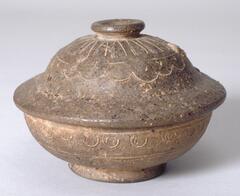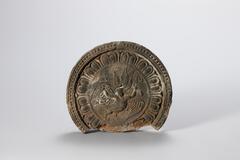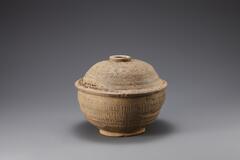11 UMMA Objects
11 UMMA Objects

Korean (Korean (culture or style))
Cinerary urn with triangular circle-and-dot design
7th century
Gift of Mrs. Caroline I. Plumer for the James Marshall Plumer Collection
1973/2.36A&B
![This curved tile has small circles lining the edge of the two long, curved edges, and two shorter straight edges without special border decoration. The face of the tile is decorated with vegetal arabesque motif.<br />
<br />
This gray-white, low-fired earthenware concave eave-end roof tile features a scroll design. Although each motif on the front decorative surface of the tile is different, the scroll design demonstrates some degree of left-right symmetry. Traces of a parallel pattern made by a paddle four centimeters wide are visible on the flat surface of the tile. Traces of trimming and smoothing with water are also visible on the sides and joints.
<p>[Korean Collection, University of Michigan Museum of Art (2017) p. 40]</p>
This curved tile has small circles lining the edge of the two long, curved edges, and two shorter straight edges without special border decoration. The face of the tile is decorated with vegetal arabesque motif.<br />
<br />
This gray-white, low-fired earthenware concave eave-end roof tile features a scroll design. Although each motif on the front decorative surface of the tile is different, the scroll design demonstrates some degree of left-right symmetry. Traces of a parallel pattern made by a paddle four centimeters wide are visible on the flat surface of the tile. Traces of trimming and smoothing with water are also visible on the sides and joints.
<p>[Korean Collection, University of Michigan Museum of Art (2017) p. 40]</p>](/media/W1siZiIsIjIwMjEvMDIvMTkvOHh3OXdiaXozOV9kZWZhdWx0LmpwZyJdLFsicCIsInRodW1iIiwiMjQweDIwMCJdXQ?sha=c308a2996283af45)
Korean (Korean (culture or style))
Untitled
676 – 935
On loan from the YooGeum Museum, Seoul, Korea
LTL2009.7.11
![This stoneware vessel consists of a bowl and lid. The curved hemispheric lid has a ring-shaped knob in the center and is decorated a lot of dot line design. The hemispheric bowl stands on the low foot with a flat base. This part is also decorated with stamped design.<br />
<br />
This is a dark gray, high-fired stoneware lidded bowl decorated with a stamped design. A ring-shaped knob at the top of the lid is surrounded by vertically aligned dotted designs radiating outwards. The bowl rim is rounded, while two narrowly incised lines surround its widest part, located just below the lip of the rim where the lid rests. Below these lines, the body is stamped with a continuous, vertically aligned, horseshoe pattern. The short and broad horseshoe motif conveys a sense of stability.
<p>[Korean Collection, University of Michigan Museum of Art (2017) p. 78]</p>
This stoneware vessel consists of a bowl and lid. The curved hemispheric lid has a ring-shaped knob in the center and is decorated a lot of dot line design. The hemispheric bowl stands on the low foot with a flat base. This part is also decorated with stamped design.<br />
<br />
This is a dark gray, high-fired stoneware lidded bowl decorated with a stamped design. A ring-shaped knob at the top of the lid is surrounded by vertically aligned dotted designs radiating outwards. The bowl rim is rounded, while two narrowly incised lines surround its widest part, located just below the lip of the rim where the lid rests. Below these lines, the body is stamped with a continuous, vertically aligned, horseshoe pattern. The short and broad horseshoe motif conveys a sense of stability.
<p>[Korean Collection, University of Michigan Museum of Art (2017) p. 78]</p>](/media/W1siZiIsIjIwMjIvMDkvMjQvMjdlZTg4d3JyZF9kZWZhdWx0LmpwZyJdLFsicCIsInRodW1iIiwiMjQweDIwMCJdXQ?sha=2326346688ebc446)
Korean (Korean (culture or style))
Cinerary Urn or Reliquary with stamped "fish scale" designs
600 – 799
Gift of Bruce and Inta Hasenkamp and Museum purchase made possible by Elder and Mrs. Sang-Yong Nam
2004/1.204A&B
![The decoration of this tile-end consists of lotus medallion with eight petals in the center surrounded by eight heart-shaped bosanghwa(Buddhist floral pattern) just inside the rim. The rim is decorated with a chain of beads.<br />
<br />
This yellowish gray, high-fired earthenware convex eaveend roof tile features an eight-petal lotus floral medallion design. It is made from fine clay and robust in appearance. The tile features a central two-tier, eight-petal lotus design, surrounded by a palmette (or bosanghwa ) design, consisting of eight heart-shaped petals, in low relief.
<p>[Korean Collection, University of Michigan Museum of Art (2017) p. 40]</p>
<br />
The decoration of this tile-end consists of lotus medallion with eight petals in the center surrounded by eight heart-shaped bosanghwa(Buddhist floral pattern) just inside the rim. The rim is decorated with a chain of beads.<br />
<br />
This yellowish gray, high-fired earthenware convex eaveend roof tile features an eight-petal lotus floral medallion design. It is made from fine clay and robust in appearance. The tile features a central two-tier, eight-petal lotus design, surrounded by a palmette (or bosanghwa ) design, consisting of eight heart-shaped petals, in low relief.
<p>[Korean Collection, University of Michigan Museum of Art (2017) p. 40]</p>
<br />
](/media/W1siZiIsIjIwMjIvMDkvMjQvN2Vzb3hndzhtal9kZWZhdWx0LmpwZyJdLFsicCIsInRodW1iIiwiMjQweDIwMCJdXQ?sha=a11d47260113b54c)
Korean (Korean (culture or style))
Roof Tile
676 – 935
Gift of Bruce and Inta Hasenkamp and Museum purchase made possible by Elder and Mrs. Sang-Yong Nam
2004/1.202

Korean (Korean (culture or style))
Roof-end tile with kalavinka design
676 – 935
On loan from the YooGeum Museum, Seoul, Korea
LTL2009.7.8

Korean (Korean (culture or style))
Cinerary urn with concentric circles design
600 – 799
Gift of Mrs. Caroline I. Plumer for the James Marshall Plumer Collection
1973/2.34A&B
![Stoneware bottle with a squat body, cylindrical neck, flared rim and natural ash glaze. A band stretches along the base of the neck demarcated by two outside lines, and a stamped row of stylized flowers centered in between them. Below the band the body of the bottle dramatically begins to curve outward. Along the body are a series of vertical comb-punched radiating lines.<br />
<br />
This is a dark gray, high-fired stoneware bottle decorated with a stamped design. The shape of the body is spheroidal, while its mouth is wide. A set of raised bands surrounds the center of the neck, while the area below is decorated with a row of stamped semicircular motifs. The upper part of the body is surrounded by rows of vertical dotted lines which have subsequently been erased from parts of the lower body by paring during rotation. The foot is low and slightly splayed.
<p>[Korean Collection, University of Michigan Museum of Art (2017) p. 82]</p>
Stoneware bottle with a squat body, cylindrical neck, flared rim and natural ash glaze. A band stretches along the base of the neck demarcated by two outside lines, and a stamped row of stylized flowers centered in between them. Below the band the body of the bottle dramatically begins to curve outward. Along the body are a series of vertical comb-punched radiating lines.<br />
<br />
This is a dark gray, high-fired stoneware bottle decorated with a stamped design. The shape of the body is spheroidal, while its mouth is wide. A set of raised bands surrounds the center of the neck, while the area below is decorated with a row of stamped semicircular motifs. The upper part of the body is surrounded by rows of vertical dotted lines which have subsequently been erased from parts of the lower body by paring during rotation. The foot is low and slightly splayed.
<p>[Korean Collection, University of Michigan Museum of Art (2017) p. 82]</p>](/media/W1siZiIsIjIwMjIvMDkvMjQvMzg5Zmw5ZG9nc19kZWZhdWx0LmpwZyJdLFsicCIsInRodW1iIiwiMjQweDIwMCJdXQ?sha=9b777eff01ef9ade)
Korean (Korean (culture or style))
Bottle with Stamped Flower and Bead Designs
600 – 799
Gift of Bruce and Inta Hasenkamp and Museum purchase made possible by Elder and Mrs. Sang-Yong Nam
2004/1.194
![This lotus medallion designed on this round tile-end consists of thirteen petals. The outer rim is decorated with eighteen round dents. The inner ring of the seedpod contains a big central seed surrounded by seven peripheral seeds. The outer rim is embellished with a bead pattern.<br />
<br />
This gray-white, low-fired earthenware tile features a single-tier, thirteen-petal lotus design and is made from fine clay. The large lotus seed at the center of the ovary is surrounded by seven slightly smaller seeds. Evidence of repair using gray clay is visible on the reverse side of the tile.<br />
[Korean Collection, University of Michigan Museum of Art (2017) p.37] This lotus medallion designed on this round tile-end consists of thirteen petals. The outer rim is decorated with eighteen round dents. The inner ring of the seedpod contains a big central seed surrounded by seven peripheral seeds. The outer rim is embellished with a bead pattern.<br />
<br />
This gray-white, low-fired earthenware tile features a single-tier, thirteen-petal lotus design and is made from fine clay. The large lotus seed at the center of the ovary is surrounded by seven slightly smaller seeds. Evidence of repair using gray clay is visible on the reverse side of the tile.<br />
[Korean Collection, University of Michigan Museum of Art (2017) p.37]](/media/W1siZiIsIjIwMjIvMDkvMjQvMjdyMTQzYWJvMF9kZWZhdWx0LmpwZyJdLFsicCIsInRodW1iIiwiMjQweDIwMCJdXQ?sha=8f0ef0df9c2ac975)
Korean (Korean (culture or style))
Roof Tile
676 – 935
Gift of Bruce and Inta Hasenkamp and Museum purchase made possible by Elder and Mrs. Sang-Yong Nam
2004/1.199
![It is a fragment of roof-end tile with apsara design in relief.<br />
<br />
This fragment of a red-brown, high-fired concave eave-end roof tile features a <em>bicheon</em> or <em>apsaras</em> (a celestial being of the clouds and waters in Hindu and Buddhist mythology) design. It is made from fine clay, resulting in a smooth surface and robust appearance. The left part of the tile is no longer present; only the heavenly cloth and cloud design remain. The narrow upper and lower rims of this tile are bordered with rows of dots, while the left and right edges have no rim. Clear traces of trimming and smoothing with water are visible on the edges and back of the tile.<br />
[Korean Collection, University of Michigan Museum of Art (2017) p.36] It is a fragment of roof-end tile with apsara design in relief.<br />
<br />
This fragment of a red-brown, high-fired concave eave-end roof tile features a <em>bicheon</em> or <em>apsaras</em> (a celestial being of the clouds and waters in Hindu and Buddhist mythology) design. It is made from fine clay, resulting in a smooth surface and robust appearance. The left part of the tile is no longer present; only the heavenly cloth and cloud design remain. The narrow upper and lower rims of this tile are bordered with rows of dots, while the left and right edges have no rim. Clear traces of trimming and smoothing with water are visible on the edges and back of the tile.<br />
[Korean Collection, University of Michigan Museum of Art (2017) p.36]](/media/W1siZiIsIjIwMjIvMDUvMjUvMnhzNjhzNDE3X2RlZmF1bHQuanBnIl0sWyJwIiwidGh1bWIiLCIyNDB4MjAwIl1d?sha=798790b7fb889401)
Korean (Korean (culture or style))
Ceramic roof tile with fragment of apsara, cloud designs
676 – 935
Gift of Dr. and Mrs. Peter Greiner
1979/2.3
![Earthenware roof tile-end with molded floral pattern.<br />
The floral medallion on this tile-end consists of bosanghwa(Buddhist floral pattern) motifs which has four heart-shaped petals. The rim is decorated with a chain of beads.<br />
<br />
This dark gray, high-fired earthenware convex eave-end roof tile is decorated with a palmette motif consisting of four petals of a flower in full bloom. Also referred to as the bosanghwa (寶相華, Ch. baoxianghua , a mythical flower often used as a Buddhist decorative motif ), this motif is arranged around a central ovary. Traces of trimming and smoothing with water are visible on the sides of the tile. Traces of clay used to attach this tile to a flat tile can also be seen on the joints.
<p>[Korean Collection, University of Michigan Museum of Art (2017) p. 39]</p>
Earthenware roof tile-end with molded floral pattern.<br />
The floral medallion on this tile-end consists of bosanghwa(Buddhist floral pattern) motifs which has four heart-shaped petals. The rim is decorated with a chain of beads.<br />
<br />
This dark gray, high-fired earthenware convex eave-end roof tile is decorated with a palmette motif consisting of four petals of a flower in full bloom. Also referred to as the bosanghwa (寶相華, Ch. baoxianghua , a mythical flower often used as a Buddhist decorative motif ), this motif is arranged around a central ovary. Traces of trimming and smoothing with water are visible on the sides of the tile. Traces of clay used to attach this tile to a flat tile can also be seen on the joints.
<p>[Korean Collection, University of Michigan Museum of Art (2017) p. 39]</p>](/media/W1siZiIsIjIwMjIvMDkvMjQvNmtwNTR6cG56NF9kZWZhdWx0LmpwZyJdLFsicCIsInRodW1iIiwiMjQweDIwMCJdXQ?sha=b3199b0a88acfe0e)
Korean (Korean (culture or style))
Roof Tile-End with Floral Medallion Design
676 – 935
Gift of Bruce and Inta Hasenkamp and Museum purchase made possible by Elder and Mrs. Sang-Yong Nam
2004/1.200

Korean (Korean (culture or style))
Cinerary Urn or Reliquary with stamped circle designs
8th century
Gift of Bruce and Inta Hasenkamp and Museum purchase made possible by Elder and Mrs. Sang-Yong Nam
2004/1.205A&B
Loading…
